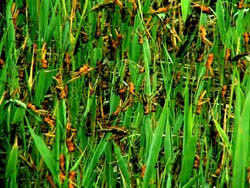
An international team, including Prof. ZHANG Zhibin from the CAS Institute of Zoology, has found that historical outbreaks of migratory locusts in China were associated with cold periods, suggesting that China's projected climate warming could decrease locust numbers.
Records made for over a thousand years in China show that locust infestations are more likely to occur following periods of cooler weather. This suggests that as climate change drives temperatures up, it may also force locust populations down as long as temperature continues to affect rainfall in the same way as it has done so far.
Contrary to its popular image, the oriental migratory locust (Locusta migratoria manilensis) is usually a loner. But surges in the locust population cause them to form massive swarms that ravish crops. Locusts have left deep scars of famine, starvation and social unrest on human history, and continue to be a periodic threat to food supplies in China and elsewhere.
More than a thousand years ago, the emperor of China decreed that local officials should keep track of locust activity each year. The hope was that this would enable them to predict when locusts would swarm.
Now those data have been used to ponder the long-term impact of climate change on the insects. "If you understand the effect of climate variation in the past, you might be better able to understand what might happen in the future," says ecologist Nils Stenseth at the University of Oslo, Norway, who helped to carry out the analysis.
Bumper crops
Nearly 50 years ago, Shijun Ma of the Chinese Academy of Sciences in Beijing looked at locust reports going back a thousand years, and found that infestations correlated with droughts and floods. When he looked at the first half of the twentieth century year by year, he also found that warmer years were more likely to yield a bumper crop of the pests, perhaps because more locusts survived through the warmer winter, he hypothesized.
Stenseth, together with Zhibin Zhang of the Chinese Academy of Sciences in Beijing, and their colleagues have now re-analysed the thousand years' worth of data, looking at it decade by decade rather than year by year as Ma had done. They found that although warmer temperatures seemed to stimulate the locusts in the short term, cooler temperatures were more conducive to locust increase in the long term. The results are reported in the Proceedings of the National Academy of Sciences1.
"We found the opposite results to Ma," says Zhang. "In the colder phase we find more locusts, in the warm phase we have less."
Soggy ground
Floods and droughts are more common during long spells of cooler weather in China. Both of these can yield the damp habitats in which the locusts lay their eggs. "In a drought year, when the river recedes, you have a favourable breeding ground for the locusts," says Leif Christian Stige, an ecologist at the University of Oslo and an author on the study. "And, also, one or two years after a flood year, you have formerly flooded areas that create a breeding habitat."
Although the team's results suggest that warmer temperatures will reduce locust populations, it remains uncertain whether the anticipated increase in temperature due to rising carbon-dioxide levels will have the same impact on rainfall as did historical climate change in this area, says Stige. So it's hard to know what the future will bring.
Nevertheless, the records provide an excellent resource for evaluating the relationship between long-term changes in climate and insect populations, comments George Sugihara at the Scripps Institution of Oceanography, La Jolla, California. It is truly remarkable for a data set to go back this far, he notes. The only problem with it, he says, is that the early data were not gathered from careful population counts, but rather were "a sort of Chinese Richter scale of locust infestation". (Source: Bio Ed)







